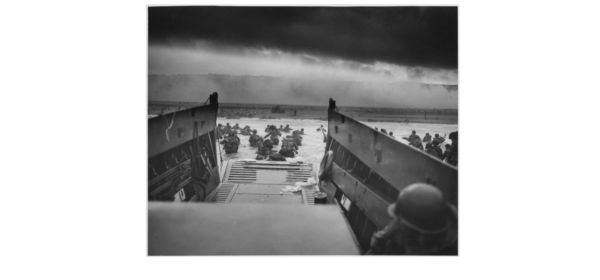
U.S. airmen stand in formation commemorating the 70th Anniversary of the Invasion of Normandy while a C-130J flies overhead. (Photo: Staff Sgt. Sara Keller, U.S. Air Force)
The Anniversary of D-Day honors U.S. and Allied troops who participated in the Invasion of Normandy on June 6, 1944.
Despite harsh weather, a logistical nightmare, and ferocious resistance, the Allies established a stalwart foothold in Western Europe, beginning a campaign that would culminate in Nazi Germany’s defeat.
Prelude to D-Day
While the Invasion of Normandy was one of the most pivotal events to take place during World War II, it didn’t occur until the twilight months of the war. For years, Nazi occupiers would reign in Western Europe facing only limited resistance. But as the Nazis’ allies began to crumble and a resurgent Soviet Union began to turn the tide in Eastern Europe, an opportunity presented itself to Western commanders.
September 1939: World War II Begins in Europe
Nazi Germany’s conquest of Europe began in 1939 with the Invasion of Poland and the partitioning of Northern Europe with the Soviet Union. By spring 1940, Nazi Germany occupied Belgium, the Netherlands, and Luxembourg while France and Great Britain prepared for the inevitable conflict ahead.
Using Belgium as a land corridor, Germany was able to bypass France’s impressive fortifications along the Maginot Line and quickly overwhelmed the French resistance. By the end of June, Nazi Germany achieved in six weeks what the German Empire could not during the entirety of World War I: the defeat of France.
Unwilling to engage in another European War only two decades removed from the end of the Great War, the United States abstained from entering the conflict despite many pleas from the Allied nations. As the French government fled to Britain, Nazi soldiers marched through Paris unopposed, leaving Great Britain as the sole opposing power in Europe until Nazi Germany’s betrayal of the Soviet Union later that year.
December 1941: Japan Attacks Pearl Harbor, Forcing the U.S. Into the War
The United States’ relative neutrality wouldn’t last forever. Two years after Nazi Germany began subjugating Europe, Imperial Japan launched a surprise attack on the seat of U.S. naval power in the Pacific, finally forcing the United States into World War II.
Even so, it would be another three years before American boots touched down on Western European soil. Rather, the United States would focus on liberating the islands captured by Imperial Japan before launching a second campaign with Britain against Nazi Germany and Fascist Italy in North Africa.
Operation Overlord
After significant progress was made against Axis forces in the Mediterranean through 1943, Allied forces in Western Europe renewed plans to liberate France and attack Germany itself. Months of planning, deception, and preparation would go into the effort — as victory or defeat in the coming battle would likely determine the outcome of the entire European theater.
June 1944: The “D-Day” Invasion of Normandy Begins

Allied troops in the Invasion of Normandy on June 6, 1944. (Photo: U.S. Library of Congress)
On June 6, 1944, U.S., British, and Canadian forces launched one of the largest amphibious assaults to ever occur across the English Channel.
Despite staunch and even fanatical resistance, Nazi Germany — which was now losing significant ground to the Soviets on the Eastern Front — suffered a catastrophic defeat. Over 150,000 Allied troops landed at Normandy, overwhelming German defenses and paving the way for a massive influx of Allied forces to reclaim all the territory Nazi Germany had taken in the years prior.
The Allies’ victory was not without loss, though. The initial landings were brutal, with some units wiped out before ever reaching Normandy’s shores. By the end of battle, both Allied and civilian casualties numbered in the tens of thousands.
May 1945: Nazi Germany Surrenders
Within a month of the D-Day landings, and after the conclusion of the Battle of Normandy, Allied invaders were able to link up with an additional offensive that had reclaimed much of southern France.
Crumbling under the pressure of a two-front war, Nazi armies were either defeated or forced to give up swaths of captured territory in France and Belgium through the remainder of 1944. Desperate winter counteroffensives in the Ardennes and Western Hungary would prove to be Nazi Germany’s final gasp before approaching Allied armies in the West and East finally forced a German surrender, officially ending World War II in Europe.
Only a few months later, the Atomic Bombings of Hiroshima and Nagasaki would mark the end of World War II entirely.
D-Day Legacy
Ultimately, the Invasion of Normandy was a massive victory for humanity in the face of hatred and oppression. As with all military and Veterans holidays, the Anniversary of the D-Day Landings honors those lost as well as those who continued to fight and die for freedom in Europe and the world.













